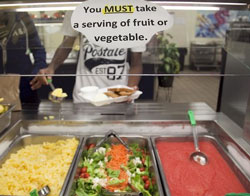 The bell had barely begun to ring in the new school year when complaints starting coming in about USDA’s “healthier” school lunch menu guidelines and the chorus is getting louder.
The bell had barely begun to ring in the new school year when complaints starting coming in about USDA’s “healthier” school lunch menu guidelines and the chorus is getting louder.
The new guidelines feature lots more healthy fresh fruits and veggies, which is great, but they also cut the portion sizes and the amount of protein served to students, which is causing concerns among parents of student athletes who are coming home hungry at the end of the day. I was first alerted to the issue by Missouri agvocate, hog producer and blogger Chris Chinn in a post she wrote on August 20. Both of her children are involved in sports and were complaining about being hungry after school so she looked into the new changes and was not too happy with what she learned.
I am in favor of kids eating healthy, and I think they should eat fruits and vegetables. What I don’t agree with though is their “one size fits all” style of feeding kids. According to the USDA meal pattern a kindergarten student who is 5 years old will receive the same amount of food as my 11 year old son who is in the 5th grade. I remember what my son ate as a kindergarten student, he didn’t eat very much. If he ate half of a peanut butter sandwich he was full. What really disturbed me was seeing that my high school student would only receive approximately 10-12 oz. of protein a week. No wonder she was starving when I picked her up. How is restricting her protein going to help nourish an athlete’s active body all day long until after games or practices? Not to mention meat promotes healthy brain development and contains zinc, iron, choline, and vitamin B, all essential for a healthy body.
So I asked Agriculture Secretary Tom Vilsack about this during his press availability at the Farm Progress Show. “First of all, moms need to know that school districts have a lot of flexibility,” Vilsack said. “There are a number of menus that are available to schools and they get to choose from those menus and some menus have varying degrees of protein levels.”
The issue appears to be a matter of cost. Fresh fruits and vegetables are often more expensive than lean protein. Less expensive protein sources like cheese, eggs and peanut butter are very restricted, if not eliminated, under the new guidelines. Therefore, even though the school lunch program is subsidized, school budgets are getting squeezed by the new guidelines. “That’s one of the reasons why we provided the first increase in school lunch reimbursement to schools in 30 years,” Vilsack said.
The main reason for the changes is to try and curb childhood obesity, so the guidelines require schools set a maximum caloric level based on certain age brackets. The first age bracket, as Chris notes, is kindergarten to 5th grade. Details of the school lunch program are available from USDA on-line.
Listen to or download Vilsack’s comments about the school lunch concerns here: Secretary Vilsack on School Lunch Concerns
